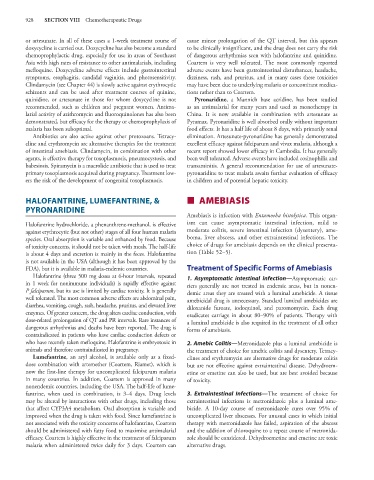Page 942 - Basic _ Clinical Pharmacology ( PDFDrive )
P. 942
928 SECTION VIII Chemotherapeutic Drugs
or artesunate. In all of these cases a 1-week treatment course of cause minor prolongation of the QT interval, but this appears
doxycycline is carried out. Doxycycline has also become a standard to be clinically insignificant, and the drug does not carry the risk
chemoprophylactic drug, especially for use in areas of Southeast of dangerous arrhythmias seen with halofantrine and quinidine.
Asia with high rates of resistance to other antimalarials, including Coartem is very well tolerated. The most commonly reported
mefloquine. Doxycycline adverse effects include gastrointestinal adverse events have been gastrointestinal disturbances, headache,
symptoms, esophagitis, candidal vaginitis, and photosensitivity. dizziness, rash, and pruritus, and in many cases these toxicities
Clindamycin (see Chapter 44) is slowly active against erythrocytic may have been due to underlying malaria or concomitant medica-
schizonts and can be used after treatment courses of quinine, tions rather than to Coartem.
quinidine, or artesunate in those for whom doxycycline is not Pyronaridine, a Mannich base acridine, has been studied
recommended, such as children and pregnant women. Antima- as an antimalarial for many years and used as monotherapy in
larial activity of azithromycin and fluoroquinolones has also been China. It is now available in combination with artesunate as
demonstrated, but efficacy for the therapy or chemoprophylaxis of Pyramax. Pyronaridine is well absorbed orally without important
malaria has been suboptimal. food effects. It has a half life of about 8 days, with primarily renal
Antibiotics are also active against other protozoans. Tetracy- elimination. Artesunate-pyronaridine has generally demonstrated
cline and erythromycin are alternative therapies for the treatment excellent efficacy against falciparum and vivax malaria, although a
of intestinal amebiasis. Clindamycin, in combination with other recent report showed lower efficacy in Cambodia. It has generally
agents, is effective therapy for toxoplasmosis, pneumocystosis, and been well tolerated. Adverse events have included eosinophilia and
babesiosis. Spiramycin is a macrolide antibiotic that is used to treat transaminitis. A general recommendation for use of artesunate-
primary toxoplasmosis acquired during pregnancy. Treatment low- pyronaridine to treat malaria awaits further evaluation of efficacy
ers the risk of the development of congenital toxoplasmosis. in children and of potential hepatic toxicity.
HALOFANTRINE, LUMEFANTRINE, & ■ AMEBIASIS
PYRONARIDINE
Amebiasis is infection with Entamoeba histolytica. This organ-
Halofantrine hydrochloride, a phenanthrene-methanol, is effective ism can cause asymptomatic intestinal infection, mild to
against erythrocytic (but not other) stages of all four human malaria moderate colitis, severe intestinal infection (dysentery), ame-
species. Oral absorption is variable and enhanced by food. Because boma, liver abscess, and other extraintestinal infections. The
of toxicity concerns, it should not be taken with meals. The half-life choice of drugs for amebiasis depends on the clinical presenta-
is about 4 days and excretion is mainly in the feces. Halofantrine tion (Table 52–5).
is not available in the USA (although it has been approved by the
FDA), but it is available in malaria-endemic countries. Treatment of Specific Forms of Amebiasis
Halofantrine (three 500 mg doses at 6-hour intervals, repeated 1. Asymptomatic intestinal infection—Asymptomatic car-
in 1 week for nonimmune individuals) is rapidly effective against riers generally are not treated in endemic areas, but in nonen-
P falciparum, but its use is limited by cardiac toxicity. It is generally demic areas they are treated with a luminal amebicide. A tissue
well tolerated. The most common adverse effects are abdominal pain, amebicidal drug is unnecessary. Standard luminal amebicides are
diarrhea, vomiting, cough, rash, headache, pruritus, and elevated liver diloxanide furoate, iodoquinol, and paromomycin. Each drug
enzymes. Of greater concern, the drug alters cardiac conduction, with eradicates carriage in about 80–90% of patients. Therapy with
dose-related prolongation of QT and PR intervals. Rare instances of a luminal amebicide is also required in the treatment of all other
dangerous arrhythmias and deaths have been reported. The drug is forms of amebiasis.
contraindicated in patients who have cardiac conduction defects or
who have recently taken mefloquine. Halofantrine is embryotoxic in 2. Amebic Colitis—Metronidazole plus a luminal amebicide is
animals and therefore contraindicated in pregnancy. the treatment of choice for amebic colitis and dysentery. Tetracy-
Lumefantrine, an aryl alcohol, is available only as a fixed- clines and erythromycin are alternative drugs for moderate colitis
dose combination with artemether (Coartem, Riamet), which is but are not effective against extraintestinal disease. Dehydroem-
now the first-line therapy for uncomplicated falciparum malaria etine or emetine can also be used, but are best avoided because
in many countries. In addition, Coartem is approved in many of toxicity.
nonendemic countries, including the USA. The half-life of lume-
fantrine, when used in combination, is 3–4 days. Drug levels 3. Extraintestinal Infections—The treatment of choice for
may be altered by interactions with other drugs, including those extraintestinal infections is metronidazole plus a luminal ame-
that affect CYP3A4 metabolism. Oral absorption is variable and bicide. A 10-day course of metronidazole cures over 95% of
improved when the drug is taken with food. Since lumefantrine is uncomplicated liver abscesses. For unusual cases in which initial
not associated with the toxicity concerns of halofantrine, Coartem therapy with metronidazole has failed, aspiration of the abscess
should be administered with fatty food to maximize antimalarial and the addition of chloroquine to a repeat course of metronida-
efficacy. Coartem is highly effective in the treatment of falciparum zole should be considered. Dehydroemetine and emetine are toxic
malaria when administered twice daily for 3 days. Coartem can alternative drugs.

